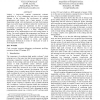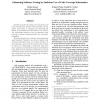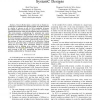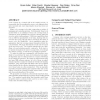ASPDAC
2011
ACM
13 years 8 months ago
2011
ACM
— Code coverage is a popular method to find design bugs and verification loopholes. However, once a piece of code is determined to be unreachable, diagnosing the cause of the p...
COMPSAC
2010
IEEE
14 years 2 months ago
2010
IEEE
An important goal of automatic testing techniques, including random testing is to achieve high code coverage with a minimum set of test cases. To meet this goal, random testing res...
CASCON
1996
14 years 6 months ago
1996
The estimation of reliability of modules using code coverage is motivated by a two-phase method for estimating the quality of software using static structure and predicted quality...
102
click to vote
AADEBUG
2005
Springer
14 years 10 months ago
2005
Springer
Code coverage analysis, the process of finding code exercised by a particular set of test inputs, is an important component of software development and verification. Most tradit...
ISSRE
2005
IEEE
14 years 10 months ago
2005
IEEE
Code prioritization for testing promises to achieve the maximum testing coverage with the least cost. This paper presents an innovative method to provide hints on which part of co...
APSEC
2005
IEEE
14 years 10 months ago
2005
IEEE
Testing a large-scale, real-life commercial software application is a very challenging task due to the constant changes in the software, the involvement of multiple programmers an...
ICSE
2007
IEEE-ACM
14 years 11 months ago
2007
IEEE-ACM
Recently, tools for the analysis and visualization of code coverage have become widely available. At first glance, their value in assessing and improving the quality of automated ...
ISVLSI
2007
IEEE
14 years 11 months ago
2007
IEEE
Abstract— Time-to-Market plays a central role on System-ona-Chip (SoC) competitiveness and the quality of the final product is a matter of concern as well. As SoCs complexity in...
ISSTA
2009
ACM
14 years 11 months ago
2009
ACM
Code coverage is a common aid in the testing process. It is generally used for marking the source code segments that were executed and, more importantly, those that were not execu...
ICSE
2009
IEEE-ACM
14 years 11 months ago
2009
IEEE-ACM
Code coverage is a common measure for quantitatively assessing the quality of software testing. Code coverage indicates the fraction of code that is actually executed by tests in ...




